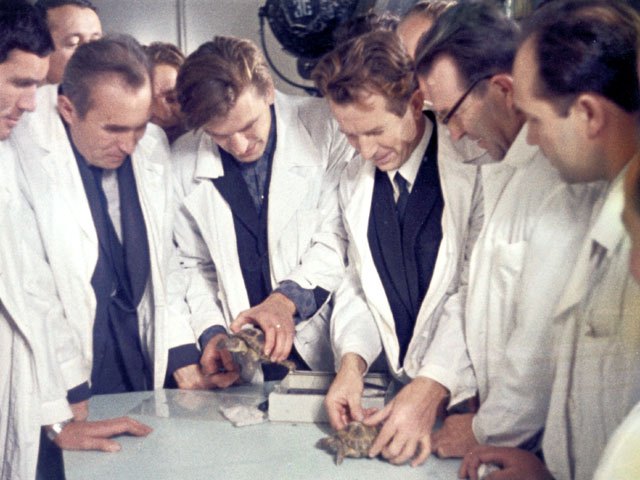In December 1968, Frank Borman, James Lovell, and William Anders, became the first men to fly around the moon and return to earth. But they were not the first earthling to do so. Only three months previously, the Soviets sent a Soyuz capsule to circle around the earth’s natural satellite carrying a large number of living creatures. Among these were two Steppe tortoises, hundreds of Drosophila eggs, various plants, and different strains of bacteria. This was only the second time that a spacecraft launched from the earth had reached the moon, and the first one to come back safely.

The Zond-5 spacecraft is being prepared for flight.
The Zond 5 mission was originally designed to carry a crew of human cosmonauts around the moon, ahead of the Apollo 8 mission, but a string of failures with previous missions, including an explosion on the launch pad in July that left three ground workers dead, forced the leaders of the Soviet lunar program to reconsider the decision to put a man in their rockets. After much deliberation, it was decided that they would send not humans but a payload of assorted living biological specimens.
Soviet scientists chose two Russian tortoises, each weighting about 350 grams. Twelve days before launch, the two space-bound tortoises were secured in the vehicle and deprived of food and water. The food deprivation was a part of pathomorphological and histochemical experiments. Another pair of tortoises, used as control specimen, were kept in a vivarium and subjected to similar food deprivation. The biological payload also included fruit fly eggs, cells of wheat, barley, pea, pine, carrots and tomatoes, specimens of the wildflower species Tradescantia paludosa, three strains of the single-celled green algae Chlorella, and one strain of lysogenic bacteria. The purpose of sending a variety of terrestrial lifeforms was to test the effect of cosmic radiation on them.

Soviet scientists examine two steppe tortoises who'd just become the first earthlings to travel to another world.
Zond 5 launched on 14 September 1968 from the Baikonur Cosmodrome. After four days of travel, it reached the Moon, looped around it once and headed straight back to earth. On September 21, the reentry capsule entered the earth's atmosphere and splashed down in the Indian Ocean, and by thus it became the first spacecraft to circle the moon and return to earth. The trip, however, was far from perfect. The spacecraft’s attitude control system failed, causing the rocket to drift from the flight path, and it’s course had to corrected. When it re-entered the earth’s atmosphere, its entry was too steep, which would have killed any human occupant. It also missed is intended landing zone, which was Kazakhstan, and this delayed the recovery of the capsule by 10 hours.
Despite the mishaps, Zond 5’s success sent a chill down the spine of every NASA scientists, for it demonstrated that the Soviet were much closer to carrying out a crewed trip to the moon. In reality, the Soviets still didn’t have a launch vehicle that could carry a spacecraft around the moon with a human cargo along with all the oxygen, food, and water needed to support human life.

Photograph of the Earth taken by Zond-5 from a distance of 90,000 kilometers.
The biggest scare was caused by a small prank masterminded by Soviet cosmonaut Pavel Popovich. He recalls the incident with amusement:
In the late 1960s, we were getting ready for a flight around the Moon. At the time we sent to the Moon the so-called probes, the very same Soyuz spacecrafts, but with no crew in them. Each one of such probes was to fly around the Moon and return to Mother Earth. A major problem was for the probes to land. Of all probes launched only one landed safely. When we realized we would never make it to the Moon, we decided to engage in a little bit of hooliganism. We asked our engineers to link the on-the-probe receiver to the transmitter with a jumper wire. Moon flight missions were then controlled from a command center in Yevpatoria in the Crimea. When the probe was on its path around the Moon, I was at that center. So, I took the microphone and said: “The flight is proceeding normally, we’re approaching the surface…” Seconds later my report – as if from outer space – was received on Earth, including by the Americans. The U.S. space adviser Frank Borman got a phone call from President Nixon, who asked: “Why is Popovich reporting from the Moon?” My joke caused real turmoil. In about a month’s time Frank came to the U.S.S.R., and I was instructed to meet him at the airport. Hardly had he walked out of his plane, he shook his fist at me and said: “Hey, you, space hooligan!”
Zond 5 was an eventual success. It accomplished the first ever flyby of the moon, conducted scientific studies of cosmic space near the moon, and returned to earth with the second cosmic speed. The two tortoises were recovered alive, and it was determined that they underwent no biological changes due to the flight; the only change in them was due to starvation.
References:
# Zond 5: A prototype of the Soviet crew capsule loops behind the Moon!, Russian Space Web
# Zond 5, NASA
# Eric Betz, The First Earthlings Around the Moon Were Two Soviet Tortoises, Discover Magazine
# Colin Burgess, Rex Hall, The First Soviet Cosmonaut Team: Their Lives and Legacies



Comments
Post a Comment